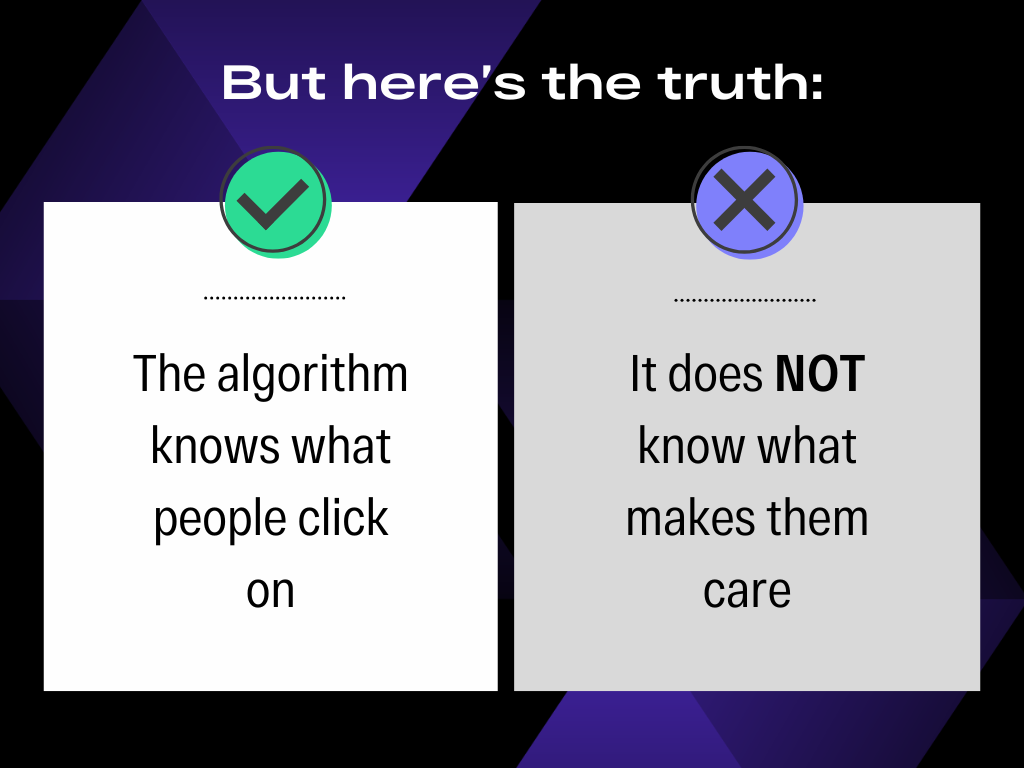
Marketers have a problem. We’ve become obsessed with chasing algorithms optimizing every ad, every post, every campaign for clicks, conversions, and “efficiency.” But somewhere along the way, we forgot about the one thing that actually makes marketing work: people.
The platforms have trained us to believe that if you just feed the algorithm what it wants, it will take care of the rest. Perfect audience targeting. Smarter bid strategies. AI-generated everything.
And don’t get me wrong. I love AI. I use it, I advocate for it, and if it could make me coffee in the morning, I’d probably propose. But let’s be real. AI doesn’t actually “get” humans. It just predicts what we might do based on past behavior.
It’s like a Spotify playlist that keeps serving up songs based on one thing you liked once. Sure, I played a ‘90s alt-rock track last week, but that doesn’t mean I need an endless stream of grunge deep cuts for the next month.

Are you marketing to actual humans, or just optimizing for pixels on a screen?
The Algorithm Trap: Why We Keep Falling for It
If you’re spending money on paid ads, you’ve seen it firsthand. The second you start getting traction, the algorithm kicks in, making sure your best-performing content keeps running until suddenly, performance tanks.
What happened? The system didn’t suddenly “stop working.” It’s just that the algorithm is optimized for engagement, not connection. It showed your content to the same type of person over and over again, until fatigue set in.
And that’s the biggest issue with algorithm-first marketing:
📌 It prioritizes immediate engagement over long-term loyalty.
📌 It follows trends instead of creating them.
📌 It turns brands into content farms instead of culture drivers.
Let me ask you this. When was the last time you saw an ad and actually remembered the brand behind it?
Audiences > Algorithms: Why Human-Led Marketing Wins Every Time
Marketing isn’t just about targeting the right person. It’s about reaching them at the right time with a message that actually lands.
You can hyper-target all you want, but if your message is forgettable, your brand is invisible.
The brands that get it don’t just “feed the algorithm”—they create demand by:
✅ Telling stories worth sharing, not just running ads that get clicks
✅ Showing up in culture, not just showing up in feeds
✅ Building actual relationships, not just retargeting past visitors
Look at how today’s consumers, especially the Slash Generation, engage with content and brands. This piece from Shingy breaks it down: They are not just clicks in a dashboard. They curate, create, and connect. Brands that ignore that will always be background noise.
That’s why focusing on audience-first marketing isn’t just a strategy. It’s the difference between being noticed and being ignored.
How to Break Free from Algorithm Dependence
I love games. Board games, strategy games, anything that makes you think a few moves ahead. But marketing shouldn’t feel like you’re stuck playing by someone else’s rules, waiting for the algorithm to decide your next move. If it feels like you’re just reacting instead of strategizing, it’s time to change the game.
1️⃣ Stop Optimizing for Engagement. Optimize for Impact.
Likes, shares, and clicks are nice, but if people don’t remember your brand, what’s the point? Too many marketers chase fleeting engagement instead of focusing on saliency, which is about staying top of mind long after someone scrolls past your content. The brands that win aren’t just seen. They stick.
Instead of obsessing over surface-level metrics, measure:
🔹 Brand recall (Are people actually talking about you weeks or months later?)
🔹 Share of voice (Are you leading conversations in your space or just adding to the noise?)
🔹 Engagement depth (Are people spending real time with your brand or just tapping and moving on?)
Salient brands don’t just capture attention. They create an impact that lasts.
2️⃣ Test Like a Human, Not a Machine.
Forget A/B testing a headline for a 0.02% lift in CTR. That’s like celebrating because your SaaS landing page got one extra visitor from Uzbekistan at 3 a.m. Instead, test things that actually move deals forward (Who knows, maybe you will pass the Cringe-O-Meter).
🔹 Emotional triggers (urgency, FOMO, pain points—anything that makes a decision-maker pay attention instead of rolling their eyes and deleting your email)
🔹 Storytelling structures (customer success narratives vs. feature dumps because nobody signs a contract just because your AI is “revolutionary”)
🔹 Formats that break the feed (unpolished, direct content usually outperforms generic explainer videos because buyers want insights, not another SaaS sales pitch with stock footage of people high-fiving)
If your content reads like it came straight from a jargon generator, it’s going to be scrolled past and forgotten. People don’t engage with content because it’s optimized. They engage because it actually helps them solve a problem.
3️⃣ Retarget Smarter, Not Harder.
Retargeting works. The problem is, most brands do it so badly it feels like digital stalking. If someone didn’t buy the first time, hitting them with the same ad ten more times isn’t “nurturing,” it’s just annoying.
🔹 Dynamic storytelling (each ad should build on the last instead of screaming “Hey, remember me?” like a desperate text at 2 a.m.)
🔹 Context-driven outreach (remind them why they cared in the first place with content that actually adds value instead of just flashing the same CTA again)
🔹 Engagement that doesn’t feel forced (give people a reason to interact with your brand, whether it’s a fresh insight, a conversation starter, or something that doesn’t immediately scream “buy now”)
If your retargeting is making people want to clear their cookies just to escape, it’s time to rethink the approach.
4️⃣ Use AI as a Tool, Not a Crutch
AI isn’t the problem. Lazy marketers using AI so they don’t have to think is the problem. If your entire strategy is dumping prompts into ChatGPT and copy-pasting whatever pops out, congratulations, you’ve officially outsourced your creativity.
AI should make you faster and sharper, not lazier and blander. Use it to:
🔹 Speed up insights (AI can crunch data, but if you’re letting it make decisions for you, you might as well flip a coin.)
🔹 Find patterns in data (AI can spot trends, but it has no common sense. Just because it says something “works” doesn’t mean it won’t make your brand look ridiculous.)
🔹 Automate the boring stuff (Let AI handle the grunt work so you can focus on big ideas, smart strategies, and content that doesn’t sound like a robot wrote it.)
Use AI to work smarter, not to avoid working. If you let it do all the thinking, don’t be shocked when your marketing sounds like every other brand using the same prompts. Use it to work smarter, not to avoid working at all.
Final Thought: Market Like a Human in a Machine-Driven World
If your marketing feels like it has been optimized to death, it probably has. The best brands are not chasing the algorithm. They create something so good that the algorithm has no choice but to follow.At SourceCode, we help brands get this right. We use data to guide strategy, not replace it. Marketing is not just about getting in front of the right people, it is about building a community, owning your audience, and showing up in a way that feels human. The brands that do this are the ones people remember. The ones that don’t, fade into the noise. Growth comes from being the brand people care about.





